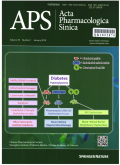- 钛学术文献服务平台 \
- 学术期刊 \
- 医药卫生期刊 \
- 药学期刊 \
- 中国药理学报(英文版)期刊 \
Engineered cardiac tissues:a novel in vitro model to investigate the pathophysiology of mouse diabetic cardiomyopathy
Engineered cardiac tissues:a novel in vitro model to investigate the pathophysiology of mouse diabetic cardiomyopathy
基本信息来源于合作网站,原文需代理用户跳转至来源网站获取
摘要:
Rodent diabetic models,used to understand the pathophysiology of diabetic cardiomyopathy(DCM),remain several limitations.Engineered cardiac tissues(ECTs)have emerged as robust 3D in vitro models to investigate structure-function relationships as well as cardiac injury and repair.Advanced glycation end-products(AGEs),produced through glycation of proteins or lipids in response to hyperglycemia,are important pathogenic factor for the development of DCM.In the current study,we developed a murine-based ECT model to investigate cardiac injury produced by AGEs.We treated ECTs composed of neonatal murine cardiac cells with AGEs and observed AGE-related functional,cellular,and molecular alterations:(1)AGEs(150 μg/mL)did not cause acute cytotoxicity,which displayed as necrosis detected by medium LDH release or apoptosis detected by cleaved caspase 3 and TUNEL staining,but negatively impacted ECT function on treatment day 9;(2)AGEs treatment significantly increased the markers of fibrosis(TGF-β,α-SMA,Ctgf,Collagen Ⅰ-α1,Collagen Ⅲ-α1,and Fn1)and hypertrophy(Nppa and Myh7);(3)AGEs treatment significantly increased ECT oxidative stress markers(3-NT,4-HNE,HO-1,CAT,and SOD2)and inflammation response markers(PAI-1,TNF-α,NF-κB,and ICAM-1);and(4)AGE-induced pathogenic responses were all attenuated by pre-application of AGE receptor antagonist FPS-ZM1(20 μM)or the antioxidant glutathione precursor N-acetylcysteine(5 mM).Therefore,AGEs-treated murine ECTs recapitulate the key features of DCM's functional,cellular and molecular pathogenesis,and may serve as a robust in vitro model to investigate cellular structure-function relationships,signaling pathways relevant to DCM and pharmaceutical intervention strategies.

推荐文章
Lyocell与Model织物风格比较
再生纤维素纤维
Lyocell织物
Model织物
风格特征
构建 SLE 患者 novel microRNA 差异性表达谱及其靶基因的功能分析
系统性红斑狼疮
新小核糖核酸
靶基因
差异性表达
GO 富集
KEGG 通路
Zircon saturation model in silicate melts: a review and update
Zircon
Zircon saturation
Model
Silicate melt
Mafic to silicic melts
Peraluminous to peralkaline compositions
Igneous rocks
Thermometer
化感--外来入侵植物的"Novel Weapons"
化感
外来入侵植物
NW假说
内容分析
关键词云
关键词热度
相关文献总数
(/次)
(/年)
文献信息
| 篇名 | Engineered cardiac tissues:a novel in vitro model to investigate the pathophysiology of mouse diabetic cardiomyopathy | ||
| 来源期刊 | 中国药理学报(英文版) | 学科 | |
| 关键词 | |||
| 年,卷(期) | 2021,(6) | 所属期刊栏目 | Cardiovascular Pharmacology |
| 研究方向 | 页码范围 | 932-941 | |
| 页数 | 10页 | 分类号 | |
| 字数 | 语种 | 英文 | |
| DOI | |||
五维指标
引文网络
引文网络
二级参考文献 (121)
共引文献 (19)
参考文献 (40)
节点文献
引证文献 (0)
同被引文献 (0)
二级引证文献 (0)
1967(1)
- 参考文献(0)
- 二级参考文献(1)
1972(2)
- 参考文献(1)
- 二级参考文献(1)
1980(1)
- 参考文献(0)
- 二级参考文献(1)
1983(1)
- 参考文献(0)
- 二级参考文献(1)
1986(1)
- 参考文献(0)
- 二级参考文献(1)
1988(2)
- 参考文献(0)
- 二级参考文献(2)
1989(2)
- 参考文献(0)
- 二级参考文献(2)
1991(1)
- 参考文献(0)
- 二级参考文献(1)
1992(2)
- 参考文献(0)
- 二级参考文献(2)
1993(2)
- 参考文献(0)
- 二级参考文献(2)
1994(6)
- 参考文献(0)
- 二级参考文献(6)
1995(8)
- 参考文献(0)
- 二级参考文献(8)
1996(8)
- 参考文献(0)
- 二级参考文献(8)
1997(10)
- 参考文献(2)
- 二级参考文献(8)
1998(8)
- 参考文献(0)
- 二级参考文献(8)
1999(9)
- 参考文献(0)
- 二级参考文献(9)
2000(15)
- 参考文献(0)
- 二级参考文献(15)
2001(14)
- 参考文献(0)
- 二级参考文献(14)
2002(4)
- 参考文献(0)
- 二级参考文献(4)
2003(14)
- 参考文献(1)
- 二级参考文献(13)
2004(4)
- 参考文献(2)
- 二级参考文献(2)
2005(2)
- 参考文献(2)
- 二级参考文献(0)
2007(2)
- 参考文献(1)
- 二级参考文献(1)
2008(1)
- 参考文献(0)
- 二级参考文献(1)
2009(2)
- 参考文献(1)
- 二级参考文献(1)
2010(2)
- 参考文献(0)
- 二级参考文献(2)
2012(3)
- 参考文献(2)
- 二级参考文献(1)
2013(2)
- 参考文献(2)
- 二级参考文献(0)
2014(1)
- 参考文献(1)
- 二级参考文献(0)
2015(2)
- 参考文献(1)
- 二级参考文献(1)
2016(5)
- 参考文献(3)
- 二级参考文献(2)
2017(10)
- 参考文献(9)
- 二级参考文献(1)
2018(12)
- 参考文献(10)
- 二级参考文献(2)
2019(1)
- 参考文献(1)
- 二级参考文献(0)
2020(1)
- 参考文献(1)
- 二级参考文献(0)
2021(0)
- 参考文献(0)
- 二级参考文献(0)
- 引证文献(0)
- 二级引证文献(0)
引文网络交叉学科
相关学者/机构
期刊影响力
中国药理学报(英文版)
主办单位:
中国药理学会和中科院上海药物研究所
出版周期:
月刊
ISSN:
1671-4083
CN:
31-1347/R
开本:
大16开
出版地:
上海市太原路294号
邮发代号:
4-295
创刊时间:
1980
语种:
eng
出版文献量(篇)
4416
总下载数(次)
2
总被引数(次)
42236
期刊文献
相关文献
推荐文献
- 期刊分类
- 期刊(年)
- 期刊(期)
- 期刊推荐
中国药理学报(英文版)2022
中国药理学报(英文版)2021
中国药理学报(英文版)2020
中国药理学报(英文版)2019
中国药理学报(英文版)2018
中国药理学报(英文版)2017
中国药理学报(英文版)2016
中国药理学报(英文版)2015
中国药理学报(英文版)2014
中国药理学报(英文版)2013
中国药理学报(英文版)2012
中国药理学报(英文版)2011
中国药理学报(英文版)2010
中国药理学报(英文版)2009
中国药理学报(英文版)2008
中国药理学报(英文版)2007
中国药理学报(英文版)2006
中国药理学报(英文版)2005
中国药理学报(英文版)2004
中国药理学报(英文版)2003
中国药理学报(英文版)2002
中国药理学报(英文版)2001
中国药理学报(英文版)2000
中国药理学报(英文版)1999
中国药理学报(英文版)1998
中国药理学报(英文版)2021年第9期
中国药理学报(英文版)2021年第8期
中国药理学报(英文版)2021年第7期
中国药理学报(英文版)2021年第6期
中国药理学报(英文版)2021年第5期
中国药理学报(英文版)2021年第4期
中国药理学报(英文版)2021年第3期
中国药理学报(英文版)2021年第2期
中国药理学报(英文版)2021年第12期
中国药理学报(英文版)2021年第11期
中国药理学报(英文版)2021年第1期

 免费查重
免费查重










